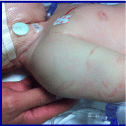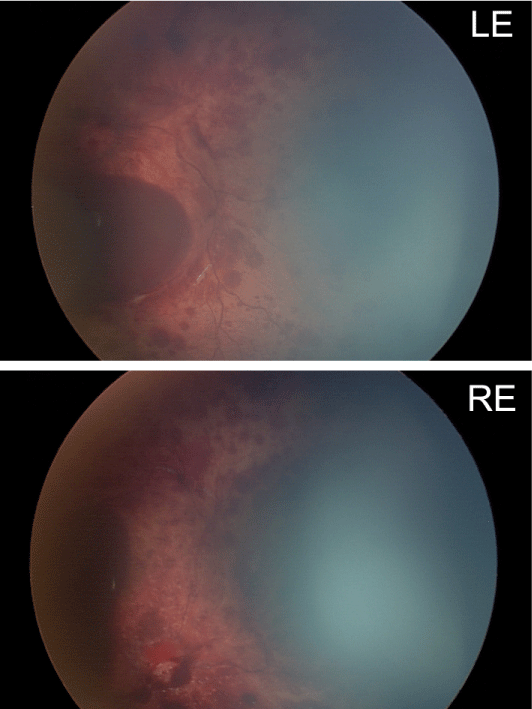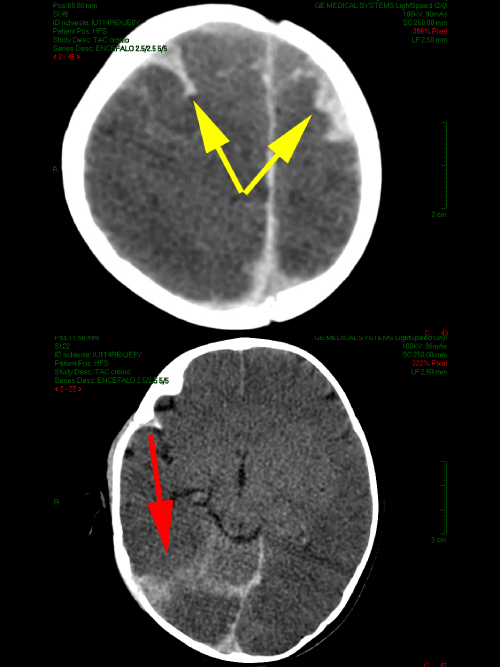
Case Report
Austin J Forensic Sci Criminol. 2015;2(3): 1024.
Report to the Prosecutor in Cases of Shaken Baby Syndrome/Abusive Head Trauma: Still an Ongoing Debate
Vincenzo M. GRASSI¹*#, Valentino DE MATTEIS1#,Silvia PULITANÒ2, Riccardo ROSSI¹ and AntonioOLIVA¹
¹Institute of Public Health- Section of Legal Medicine, Catholic University, Italy
²Pediatric Intensive Care Unit, Catholic University, Italy #These authors contributed equally to this work
*Corresponding author: Grassi VM, Institute of Public Health- Section of Legal Medicine, Catholic University of the Sacred Heart, Largo Francesco Vito 1, 00168 Rome, Italy
Received: March 26, 2015; Accepted: April 30, 2015; Published: May 21, 2015
Abstract
The shaken baby syndrome is a kind of abusive or non-accidental head trauma that occurs when a child is violently shaken, actually described using the term abusive head trauma. This pathological condition has classically been diagnosed on the so-called “triad”, characterized by the presence of subdural hemorrhage, retinal hemorrhage and neurological dysfunction. We report the case of a 5-month-old female baby found senseless and violently shaken by his father after accidentally falling from the crib. The attempt to resuscitate failed and the man took his daughter to the Emergency Department where she arrived unconscious. After a pediatric and ophthalmological examination and a brain CT, a medico-legal evaluation was requested to assess if the case was suitable for referring the matter to the State Prosecutor.
Keywords: Shaken baby syndrome; Abusive head trauma; Subdural hemorrhage; Retinal hemorrhage; Neurological dysfunction; Report to Judicial Authority
Introduction
The shaken baby syndrome is a kind of abusive or non-accidental head trauma [1] that occurs when a child is violently shaken and therefore acceleration/deceleration/rotational forces are impressed to the victims’ bodies, with or without impact [2].
In the early ‘70s Caffey and Guthkelch published their studies suggesting that violent shaking or whiplash was sufficient to produce severe neurological damages in infants [3,4].
In the last decades, the “shaken baby syndrome” has been one of the most used term in pediatrics, nevertheless the name now preferred seems to be “Abusive Head Trauma” (AHT), which is defined as “an injury to the skull or intracranial contents of an infant or young child (<5 years of age) due to inflicted blunt impact and/or violent shaking.” [5,6]. The AHT occurs mostly in young children and infants and is characterized by a high morbidity and mortality [7].
The incidence has been reported in the literature ranging from 20 to 31 cases per 100.000 children younger than 1 year [2,5], but this does not include the form of AHT presenting blurring clinical manifestation that are not reported to the physicians [2]. The mortality rate has been estimated in about 20% of cases and over [2,5]. Boys represent 65% of cases [8].
Clinically, the AHT is characterized by a seemingly inexplicable and severe decline in infant’s neurological status. In particular, physicians usually observe minimal or absent blunt head injuries, acute subdural and/or subarachnoid hemorrhage (bilateral or multifocal), cerebral edema, retinal hemorrhages [8,9]. Injury to the neck and cervical spine, fractures of limb, rib or skull and bruising in the teguments and/or neck muscles may also be present [1].
Case Presentation
We report the case of a 5-month-old female baby who was taken to the Emergency Department by her father. At time of anamnesis, the physicians learned that the father had found the baby senseless on the floor after having been fallen accidentally from the cradle. He immediately tried to resuscitate the infant by violently shaking her after grabbing her thorax and arms. The attempt to resuscitate failed and the man took his daughter to the Hospital where she arrived unconscious. The patient subsequently underwent a pediatric and ophthalmological examination and a brain CT investigation. On admission to the ED, the baby presented only an ecchymosis on the left emi-thorax (Figure 1), and an abrasion on the right arm (Figure 2). Bilateral retinal hemorrhages were also present and classified as moderate (Grade 2), according to Vinchon et al. [7] classification (Figure 3). She underwent a brain CT which showed: a subarachnoid hemorrhage involving the frontal lobes, the longitudinal cerebral fissure and around the tentorium; transverse and occipital sinus thrombosis and suspected sagittal sinus thrombosis; bihemispheric brain edema (Figure 4). Neither skeletal lesions nor fingertip bruises were detected.

Figure 1: Ecchymosis on the left emi-thorax of the patient.

Figure 2: Abrasion on the right arm of the baby.

Figure 3: Fundus oculi examination showing bilateral retinal hemorrhages.
LE: left eye. RE: right eye.

Figure 4: Brain CT revealing subarachnoid hemorrhage involving the frontal
lobes, the longitudinal cerebral fissure and the tentorium. Diffuse brain
edema.
After a 6-hour clinical observation and a new CT scan reevaluation, the clinical conditions worsened and the neurosurgeon considered it appropriate to perform a fronto-parietal bilateral decompressive craniectomy.
During the following hospitalization, the patient underwent several neurological, radiological (CT, MRI) and rehabilitative evaluations. The child survived but with poor neurologic status. After two months the baby was transferred to a neuromotor rehabilitation center. On the arrival to the Emergency Department, a medico-legal assessment was also requested in order to establish if the case was suitable for referring the matter to the State Prosecutor.
Discussion
Despite the wide range of clinical manifestation, the AHT has classically been diagnosed on the so-called “triad”, characterized by the presence of subdural hemorrhage (SDH), retinal hemorrhage (RH) and neurological dysfunction (ND) [8,9]. Particularly, the SDH may be associated with or replaced by subarachnoid hemorrhages and it is generally multifocal [10]. Nevertheless, isolated SDH in an infant without any accidental head injury has been described [11]. The presence of SDH is more frequently associated with the shaking than the impact of head on hard surfaces [1]. Bilateral RH is frequently associated with AHT, nevertheless it is absent in about 20% of cases. Therefore RH is not essential for a diagnosis, but shaking injuries should be highly suspected in children with RH and a parental explanation of accidental head damage [1,12]. ND includes a wide range of clinical manifestations, such as severe malaise, impaired vigilance, coma, acute respiratory failure, convulsions, severe cerebral edema, acute encephalopathy with a depressed conscious state, fits, apnea, hypotonia, signs suggesting acute intracranial hypertension [1,13].
According to the recommendations of the French Society of Physical Medicine and Rehabilitation, the presence of the “triad” is sufficient for a highly probable or even certain diagnosis of AHT [1]. On the other hand, some authors assert that the “triad” should not be considered an absolute proof if the clinical and anamnestic data are not suggestive of AHT [13].
The above three major clinical symptoms may be associated with various aspecific clinical signs, such as skin lesions and bruising, bone injury mainly involving the ribs, damage to neck muscles, the spine or the spinal cord [1].
As already stated, the acronym AHT is now preferred to the term “Shaken Baby Syndrome”. In fact, physiopathological and biomechanical studies have shown that an impact of the head on a hard surface produces an acceleration force of the brain much more intense than the act of shaking [8]. The acceleration/deceleration of the head produced flexion/extension injury of the weakly infant neck and the infant brain undergoes the same forces, thus producing a tearing of bridging veins and intracranial hemorrhage [10]. Some authors have proposed that diffuse axonal injury is caused by acceleration-induced shearing injury to axons and it might contribute to the neurological sequelae [10,13]. In babies under 2 years of age, the disproportion between head and body, the weakness of neck muscle, the unmyelinated axons and the flat base of the skull, make them most vulnerable to AHT [14,15].
In Italy as well as in some other European countries, physicians have the obligation to alert the Prosecutor when the life or the physical integrity of a person is in danger. The rationale behind this, is that after having notified the State Prosecutor’s Office it’s possible to initiate a penal enquiry, where the Police is, for instance, authorized to perform a broader and deeper investigation (e.g. searching for previous and similar instances of admission to the ED in different hospitals, examine eventual witnesses, etc). Lastly, it needs to be highlighted that the Italian Penal Law penalizes the health professionals who omit to alert the Judicial Authority.
In this regard, we presented the above reported case and we questioned, at the same time, the following: is the medical team who performs the physical examination on the patient, actually obliged to report to the Judicial Authority? In our case, it should be kept in mind that the decision was based exclusively on the clinical information gathered from the ED.
The medical history and interview alerted the physicians, especially because the father admitted shaking the baby in an attempt to resuscitate his daughter. Indeed, the clinical findings, including the skin lesions, the subarachnoid hemorrhage with brain edema and the bilateral retinal hemorrhages, were suggestive of shaking. Nevertheless, it was impossible to make a differential diagnosis between an abusive and a resuscitative shaking.
In fact, beside head abusive trauma also innocent shaking related to resuscitation a senseless baby, in an attempt to stop seizures [16,17], to prevent suffocation [16,18], to awake a sleeping baby [18,19] are reported in literature. Therefore, distinguishing between a real wrongdoing and an innocent action is often difficult from a clinical and forensic point of view [9]. The main significance of this differential diagnosis is represented by the decision to refer the matter to the State Prosecutor. In any case, the “absolute proof” of abuse is not necessary to report an event to the State Prosecutor’s Office. In our case, the ambiguous anamnestic data justified reporting the episode to the State Prosecutor’s Office. Moreover, accidental traumas occurring in private spaces cannot escape a measure of doubt [20] and the accidental fall from the crib (which at least could be considered a kind of child abuse because the parents didn’t take care of the baby appropriately). This case represents the ongoing challenge in the every-day forensic practice when facing these ambiguous cases at the arrival in the Emergency Department. We do believe that further research through multidisciplinary approach is needed to clarify the pathophysiologic mechanism to explain the nature of these injuries and to establish clear signs in order to reach the most reliable diagnosis according also to the clinical history and the parental interview. It is also very important to conduct an extensive investigation to achieve a cohort of cases larger enough to make appropriate inferences in forensic field.
References
- Laurent-Vannier A, Nathanson M, Quiriau F, Briand-Huchet E, Cook J, Billette de Villemeur T, et al. A public hearing "Shaken baby syndrome: guidelines on establishing a robust diagnosis and the procedures to be adopted by healthcare and social services staff". Guidelines issued by the Hearing Commission. Annals of physical and rehabilitation medicine. 2011; 54: 600-625.
- Stewart TC, Polgar D, Gilliland J, Tanner DA, Girotti MJ, Parry N, et al. Shaken baby syndrome and a triple-dose strategy for its prevention. J Trauma. 2011; 71: 1801-1807.
- Caffey J. On the theory and practice of shaking infants. Its potential residual effects of permanent brain damage and mental retardation. Am J Dis Child. 1972; 124: 161-169.
- Guthkelch AN. Infantile subdural haematoma and its relationship to whiplash injuries. Br Med J. 1971; 2: 430-431.
- Albert DM, Blanchard JW, Knox BL. Ensuring appropriate expert testimony for cases involving the "shaken baby". JAMA. 2012; 308: 39-40.
- Christian CW, Block R; Committee on Child Abuse and Neglect; American Academy of Pediatrics. Abusive head trauma in infants and children. Pediatrics. 2009; 123: 1409-1411.
- Vinchon M, Defoort-Dhellemmes S, Desurmont M, Dhellemmes P. Accidental and nonaccidental head injuries in infants: a prospective study. J Neurosurg. 2005; 102: 380-384.
- Squier W. The "Shaken Baby" syndrome: pathology and mechanisms. Acta Neuropathol. 2011; 122: 519-542.
- Miller R, Miller M. Overrepresentation of males in traumatic brain injury of infancy and in infants with macrocephaly: further evidence that questions the existence of shaken baby syndrome. The American journal of forensic medicine and pathology. 2010; 31: 165-173.
- Shannon P, Smith CR, Deck J, Ang LC, Ho M, Becker L, et al. Axonal injury and the neuropathology of shaken baby syndrome. Acta Neuropathol. 1998; 95: 625-631.
- Vinchon M, de Foort-Dhellemmes S, Desurmont M. Confessed abuse versus witnessed accidents in infants: comparison of clinical, radiological, and ophthalmological data in corroborated cases. Child's nervous system: ChNS: official journal of the International Society for Pediatric Neurosurgery. 2010; 26: 637-645.
- Togioka BM, Arnold MA, Bathurst MA, Ziegfeld SM, Nabaweesi R, Colombani PM, etal. Retinal hemorrhages and shaken baby syndrome: an evidence-based review. J Emerg Med. 2009; 37: 98-106.
- Byard RW. "Shaken baby syndrome" and forensic pathology: an uneasy interface. Forensic Sci Med Pathol. 2014; 10: 239-241.
- Case ME, Graham MA, Handy TC, Jentzen JM, Monteleone JA; National Association of Medical Examiners Ad Hoc Committee on Shaken Baby Syndrome. Position paper on fatal abusive head injuries in infants and young children. Am J Forensic Med Pathol. 2001; 22: 112-122.
- American Academy of Pediatrics: Committee on Child Abuse and Neglect. Shaken baby syndrome: rotational cranial injuries-technical report. Pediatrics. 2001; 108: 206-210.
- Benzel EC, Hadden TA. Neurologic manifestations of child abuse. South Med J. 1989; 82: 1347-1351.
- Greenwald MJ, Weiss A, Oesterle CS, Friendly DS. Traumatic retinoschisis in battered babies. Ophthalmology. 1986; 93: 618-625.
- Becker JC, Liersch R, Tautz C, Schlueter B, Andler W. Shaken baby syndrome: report on four pairs of twins. Child Abuse Negl. 1998; 22: 931-937.
- Alexander RC, Schor DP, Smith WL Jr. Magnetic resonance imaging of intracranial injuries from child abuse. J Pediatr. 1986; 109: 975-979.
- Vinchon M, Delestret I, DeFoort-Dhellemmes S. Subdural hematoma in infants: can it occur spontaneously? Data from a prospective series and critical review of the literature. Child's nervous system: ChNS : official journal of the International Society for Pediatric Neurosurgery. 2010; 26: 1195-1205.